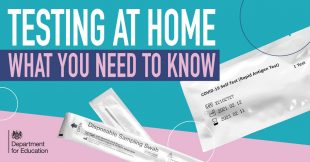
As many as one in three people with Covid are asymptomatic – meaning they have no symptoms of the virus and could spread it without knowing. In settings like schools and colleges that is obviously a concern.
But that’s where asymptomatic testing comes in. All secondary school age pupils and secondary school and college staff are able to take tests twice weekly regardless of whether they have symptoms. The first three of these tests happened in school but from the fourth test onwards pupils will take them from home.
We’re also asking families and carers with secondary school age children to take tests at home as well. The more tests are carried out, the safer our communities will be.
Here are five things you need to know about home testing:
1. Home Testing Kits are Easy to Use
Home testing kits are simple and easy to use – and they give a clear result in just 30 minutes.
A swab is used to take a sample from the nose or throat, that swab is then dipped in a liquid provided with the test which is then applied to a piece of paper embedded in a stick that then gives a reading in 30 minutes. It’s very similar to taking a pregnancy test.
To help the process, we’ve pulled together a guide providing clear information on how to use the home testing kits successfully.
For parents who need to help a child take their test, you can read the instructions here.
2. The tests are helping identify individuals with Covid who do not have symptoms
It is extremely unlikely that people will test positive when they don’t have the virus.
Home testing kits come with Lateral Flow (LFD) tests, which are the same tests taken in schools; the only difference is these tests are being taken without teacher/staff supervision.
Staff or pupils with a positive LFD test result from a home test will need to self-isolate in line with the guidance and arrange a follow up test to confirm the result. This is done by clicking here.
3. If you have a Negative PCR Covid-19 follow up test, you do not need to self-isolate
If a lateral flow test is negative, users do not need to get a second test to confirm this result.
While a negative Covid test means you do not need to self-isolate, you should continue to follow coronavirus rules, including regular hand washing, social distancing and wearing face coverings where required. You can read more about the other measures that have been put in place to drive down cases and break chains of transmission here.
4. Whole households should take tests, not just pupils
It’s not just children and young people who should be taking tests – if you are in the same family as a child attending secondary school or college you should test yourself twice a week too. This includes the families and households of school staff.
5. The tests are easy to get hold of
You can also order kits to test your household, childcare bubble or support bubble here if at least one member:
- is a school, nursery or college pupil
- works in a school, nursery, early years provider such as childminders, or college (this includes temporary workers or volunteers)
- works in an occupation related to a school, nursery, early years provider or college.
A test kit contains seven tests, and you can order one test kit per household each day. A flat share or house share counts as a household.